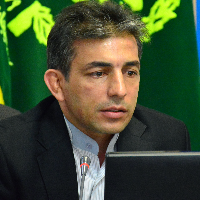Studying of the extreme temperature events in East Azerbaijan for 2009-2049
One of the important impacts of climate change and global warming is the increasing of extreme atmospheric phenomena. The most destructive effects of climate change are in areas with arid climate, which is highly dependent on water resources and climate which Iran is one of these areas. Generally, East Azerbaijan in North West of Iran has a cold and dry climate. Because of the diversity in topography it has different climates. The mean annual rainfall is 250 to 300 mm and the average temperature is 12 °C. The long-term mean temperature in the warm period (June, July and August) is 24-34 °C and in the cold period (December, January, February and March) 0 - -7°C respectively. Reducing the consequences of climate in the future, depends on identifying the mechanism of extreme phenomena such as heat and cold waves, the synoptic patterns of them, finding solutions to reduce its effects as well as identifying vulnerable areas. Therefore, it is necessary to conduct the studies on extreme atmospheric phenomena.
17 synoptic meteorological synoptic stations' data were used for the occurrence of extreme temperature events. Heat and cold waves were studied for warm (June, July and August) and cold (December, January, February and March) period of year respectively. Heat and cold waves were evaluated based on three indices, frequency, intensity and duration, which are defined as follows. Heat wave frequency: Heat wave is defined based on the increase in maximum temperature relative to 95% percent of long-term values over 5 days in each station. Heat duration: Number of days with heat wave, Heat wave intensity: difference between the average maximum temperature during the heatwave and long-term in the same period for each station, Cold wave frequency: Cold wave based on a significant decrease in minimum temperature compared to the previous day. One percentile of long term values for the difference in minimum temperature relative to the previous day is defined as the significant limit of the cold wave for each station. Cold duration: Number of days with cold wave, Cold wave intensity: Maximum decreasing in temperature during cold wave that leads to subzero temperature for each station. First, the trend of heat and cold waves indices were investigated for stations with long term data (Tabriz, Ahar, Jolfa, Maragheh and Sarab).Then the non-parametric Mann-Whitney comparison test was used to compare changes between decades. According to the results, the spatial distribution of extreme temperature events was presented for the East Azerbaijan. The impact of the climate change on the maximum and minimum temperature were evaluated by downscaling model SDSM to predict the probability of occurrence in the coming years and identify the affected areas in the province.
The results of the study for trend showed the increasing of heat wave events for all stations. Due to the significant difference of the last decade (2006-2018) compared to previous decades, the spatial distribution of heat and cold wave events (frequency, duration and intensity) for the recent period were compared. Examining the spatial distribution of heat wave occurrences in the last 10 years showed that, the frequency of heat wave occurred more in the southwest, duration in the western regions and intensity in the northern regions of the province compared to other regions. The results showed that the frequency of cold events in the northeast, east and part of the southwest, duration in the northeast (Arasbaran region) and north (along the Aras River) and the intensity in the east and northeast of the province are more than other areas. The results of climate change scenarios compare to baseline period (1961-2005) showed that the northwestern and central regions of the province will experience an increase in temperature between 5-6 °C and the rest of the province between 3.5-5 °C in the warm season. This indicates an increase in occurrence of heat waves. Also, according to the climate prediction in 2020-2049 the minimum temperature in the cold season will increase in the eastern, southeastern and northwestern regions of the province for 2-3 °C and the rest of the province for 0.5-2 °C.
Considering the impact of climate change in the coming years, it is predicted that East Azerbaijan province will witness extreme temperature events (heat and cold waves). The results of this research play an important role not only in seasonal forecasting but also in the provincial management planning.
- حق عضویت دریافتی صرف حمایت از نشریات عضو و نگهداری، تکمیل و توسعه مگیران میشود.
- پرداخت حق اشتراک و دانلود مقالات اجازه بازنشر آن در سایر رسانههای چاپی و دیجیتال را به کاربر نمیدهد.


